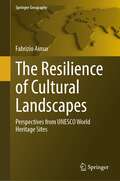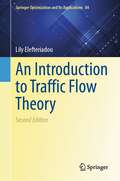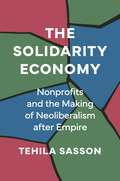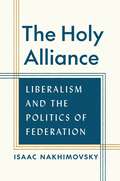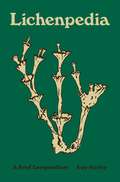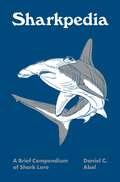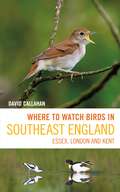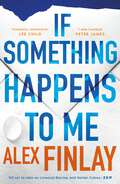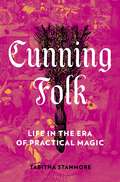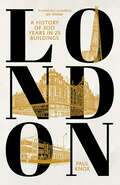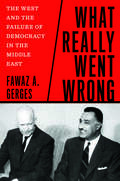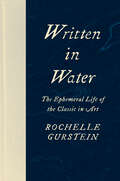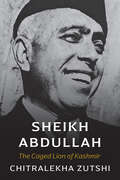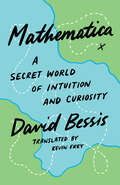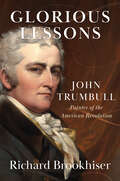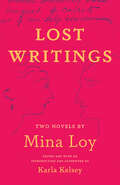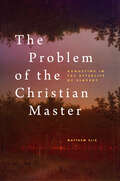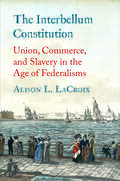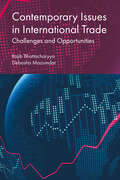- Table View
- List View
The Resilience of Cultural Landscapes: Perspectives from UNESCO World Heritage Sites (Springer Geography)
by Fabrizio AimarThis book explores the possibility of building the resilience of the UNESCO cultural landscapes, both using theoretical conceptions and practical strategies and actions. Two case studies have been selected, one in Italy and one in China, which have then been explored for the first time in such a comparative way. Different notions of landscape, as well as the driving force of changes affecting these landscapes, are examined and compared. Moreover, the perceptions of the local communities regarding these landscapes are examined, using online questionnaires with over 400 participants. This research highlights the need for an integrated management system, building stronger rural communities able to manage change and continuity. Five pillars to build the resilience of these landscapes have been provided, with schemes and figures, requiring a people-centered approach in their management. This book demonstrates strong connections between identity and landscape resilience, especially in inlandareas where the sense of identity is most prominent. Furthermore, it is structured to make it possible to replicate this investigation in ordinary case studies, i.e. ordinary landscapes. Scholars and professionals interested in cultural landscapes and heritage conservation are target of this book, as well as site managers.
An Introduction to Traffic Flow Theory (Springer Optimization and Its Applications #84)
by Lily ElefteriadouThis second edition of An Introduction to Traffic Flow Theory adds new material in several chapters related to advanced technologies including autonomy, the use of sensors and communications, and particularly congestion mitigation solutions that leverage connected and autonomous vehicles (CAVs). It also includes a new chapter that briefly outlines several mathematical analysis techniques commonly used in traffic flow theory, aiming to introduce students to some of the most frequently used tools available for traffic operational-related analysis. This new edition also includes several updates related to the most recent versions of the Highway Capacity Manual and the Green Book. This textbook is meant for use in advanced undergraduate/graduate level courses in traffic flow theory with prerequisites including two semesters of calculus, statistics, and an introductory course in transportation. The text would also be of interest to transportation professionals as a refresherin traffic flow theory or as a reference. Students and engineers of diverse backgrounds will find this text accessible and applicable to today’s traffic issues.This text provides a comprehensive and concise treatment of the topic of traffic flow theory and includes several topics relevant to today’s highway transportation system. It provides the fundamental principles of traffic flow theory as well as applications of those principles for evaluating specific types of facilities (freeways, intersections, etc.). Newer concepts of Intelligent transportation systems (ITS) and their potential impact on traffic flow are discussed. State-of-the-art traffic flow research, microscopic traffic analysis, and traffic simulation have significantly advanced and are also discussed in this text. Real-world examples and useful problem sets complement each chapter.
The Solidarity Economy: Nonprofits and the Making of Neoliberalism after Empire
by Tehila SassonThe untold story of the role of humanitarian NGOs in building the neoliberal order after empireAfter India gained independence in 1947, Britain reinvented its role in the global economy through nongovernmental aid organizations. Utilizing existing imperial networks and colonial bureaucracy, the nonprofit sector sought an ethical capitalism, one that would equalize relationships between British consumers and Third World producers as the age of empire was ending. The Solidarity Economy examines the role of nonstate actors in the major transformations of the world economy in the postwar era, showing how British NGOs charted a path to neoliberalism in their pursuit of ethical markets.Between the 1950s and 1990s, nonprofits sought to establish an alternative to Keynesianism through their welfare and development programs. Encouraging the fair trade of commodities and goods through microfinance, consumer boycotts, and corporate social responsibility, these programs emphasized decentralization, privatization, and entrepreneurship. Tehila Sasson tells the stories of the activists, economists, politicians, and businessmen who reimagined the marketplace as a workshop for global reform. She reveals how their ideas, though commonly associated with conservative neoliberal policies, were part of a nonprofit-driven endeavor by the liberal left to envision markets as autonomous and humanizing spaces, facilitating ethical relationships beyond the impersonal realm of the state.Drawing on dozens of newly available repositories from nongovernmental, international, national, and business archives, The Solidarity Economy reconstructs the political economy of these markets—from handicrafts and sugar to tea and coffee—shedding critical light on the postimperial origins of neoliberalism.
The Solidarity Economy: Nonprofits and the Making of Neoliberalism after Empire
by Tehila SassonThe untold story of the role of humanitarian NGOs in building the neoliberal order after empireAfter India gained independence in 1947, Britain reinvented its role in the global economy through nongovernmental aid organizations. Utilizing existing imperial networks and colonial bureaucracy, the nonprofit sector sought an ethical capitalism, one that would equalize relationships between British consumers and Third World producers as the age of empire was ending. The Solidarity Economy examines the role of nonstate actors in the major transformations of the world economy in the postwar era, showing how British NGOs charted a path to neoliberalism in their pursuit of ethical markets.Between the 1950s and 1990s, nonprofits sought to establish an alternative to Keynesianism through their welfare and development programs. Encouraging the fair trade of commodities and goods through microfinance, consumer boycotts, and corporate social responsibility, these programs emphasized decentralization, privatization, and entrepreneurship. Tehila Sasson tells the stories of the activists, economists, politicians, and businessmen who reimagined the marketplace as a workshop for global reform. She reveals how their ideas, though commonly associated with conservative neoliberal policies, were part of a nonprofit-driven endeavor by the liberal left to envision markets as autonomous and humanizing spaces, facilitating ethical relationships beyond the impersonal realm of the state.Drawing on dozens of newly available repositories from nongovernmental, international, national, and business archives, The Solidarity Economy reconstructs the political economy of these markets—from handicrafts and sugar to tea and coffee—shedding critical light on the postimperial origins of neoliberalism.
The Holy Alliance: Liberalism and the Politics of Federation
by Isaac NakhimovskyA major new account of the post-Napoleonic Holy Alliance and the promise it held for liberalsThe Holy Alliance is now most familiar as a label for conspiratorial reaction. In this book, Isaac Nakhimovsky reveals the Enlightenment origins of this post-Napoleonic initiative, explaining why it was embraced at first by many contemporary liberals as the birth of a federal Europe and the dawning of a peaceful and prosperous age of global progress. Examining how the Holy Alliance could figure as both an idea of progress and an emblem of reaction, Nakhimovsky offers a novel vantage point on the history of federative alternatives to the nation state. The result is a clearer understanding of the recurring appeal of such alternatives—and the reasons why the politics of federation has also come to be associated with entrenched resistance to liberalism&’s emancipatory aims.Nakhimovsky connects the history of the Holy Alliance with the better-known transatlantic history of eighteenth-century constitutionalism and nineteenth-century efforts to abolish slavery and war. He also shows how the Holy Alliance was integrated into a variety of liberal narratives of progress. From the League of Nations to the Cold War, historical analogies to the Holy Alliance continued to be drawn throughout the twentieth century, and Nakhimovsky maps how some of the fundamental political problems raised by the Holy Alliance have continued to reappear in new forms under new circumstances. Time will tell whether current assessments of contemporary federal systems seem less implausible to future generations than initial liberal expectations of the Holy Alliance do to us today.
The Holy Alliance: Liberalism and the Politics of Federation
by Isaac NakhimovskyA major new account of the post-Napoleonic Holy Alliance and the promise it held for liberalsThe Holy Alliance is now most familiar as a label for conspiratorial reaction. In this book, Isaac Nakhimovsky reveals the Enlightenment origins of this post-Napoleonic initiative, explaining why it was embraced at first by many contemporary liberals as the birth of a federal Europe and the dawning of a peaceful and prosperous age of global progress. Examining how the Holy Alliance could figure as both an idea of progress and an emblem of reaction, Nakhimovsky offers a novel vantage point on the history of federative alternatives to the nation state. The result is a clearer understanding of the recurring appeal of such alternatives—and the reasons why the politics of federation has also come to be associated with entrenched resistance to liberalism&’s emancipatory aims.Nakhimovsky connects the history of the Holy Alliance with the better-known transatlantic history of eighteenth-century constitutionalism and nineteenth-century efforts to abolish slavery and war. He also shows how the Holy Alliance was integrated into a variety of liberal narratives of progress. From the League of Nations to the Cold War, historical analogies to the Holy Alliance continued to be drawn throughout the twentieth century, and Nakhimovsky maps how some of the fundamental political problems raised by the Holy Alliance have continued to reappear in new forms under new circumstances. Time will tell whether current assessments of contemporary federal systems seem less implausible to future generations than initial liberal expectations of the Holy Alliance do to us today.
Lichenpedia: A Brief Compendium (Pedia Books #11)
by Kay HurleyAn illustrated mini-encyclopedia about the weird and wonderful world of lichensLichenpedia is a delightfully entertaining and beautifully illustrated A–Z treasury about the strange, obscure, and remarkable world of lichens, from their unique and essential roles in nature and the ways they are used in dyeing, brewing, and drug-making to how they have inspired writers and artists, from Henry David Thoreau to modern painters.In 100 brief entries written in a vivid, lively style, Kay Hurley introduces key aspects of lichen biology, environmental roles, emerging uses, scientific history, and myth. She describes the variety of forms that lichens take, from leafy to filamentous to things reminiscent of skin diseases, with imaginative names like witch&’s hair. She explains the surprising ways that birds and beasts—from reindeer and moose down to tiny tardigrades—use lichens, and how lichens survive in extreme environments, from deserts to Antarctica to outer space. Hurley also introduces some of the innovators who have advanced the knowledge of lichens, from the ancient Greek philosopher Theophrastus to today&’s professional lichenologists.With charming drawings by Susan Adele Edwards, Lichenpedia promises to put you in touch with the natural world in a new way by opening your eyes to these vital organisms, which are all around us, hidden in plain sight.Features a cloth cover with an elaborate foil-stamped design
Lichenpedia: A Brief Compendium (Pedia Books #11)
by Kay HurleyAn illustrated mini-encyclopedia about the weird and wonderful world of lichensLichenpedia is a delightfully entertaining and beautifully illustrated A–Z treasury about the strange, obscure, and remarkable world of lichens, from their unique and essential roles in nature and the ways they are used in dyeing, brewing, and drug-making to how they have inspired writers and artists, from Henry David Thoreau to modern painters.In 100 brief entries written in a vivid, lively style, Kay Hurley introduces key aspects of lichen biology, environmental roles, emerging uses, scientific history, and myth. She describes the variety of forms that lichens take, from leafy to filamentous to things reminiscent of skin diseases, with imaginative names like witch&’s hair. She explains the surprising ways that birds and beasts—from reindeer and moose down to tiny tardigrades—use lichens, and how lichens survive in extreme environments, from deserts to Antarctica to outer space. Hurley also introduces some of the innovators who have advanced the knowledge of lichens, from the ancient Greek philosopher Theophrastus to today&’s professional lichenologists.With charming drawings by Susan Adele Edwards, Lichenpedia promises to put you in touch with the natural world in a new way by opening your eyes to these vital organisms, which are all around us, hidden in plain sight.Features a cloth cover with an elaborate foil-stamped design
Sharkpedia: A Brief Compendium of Shark Lore (Pedia Bks. #13)
by Daniel AbelA fun, pocket-size A–Z treasury about sharks, featuring fascinating, little-known facts and captivating illustrationsSharkpedia is an entertaining and enlightening celebration of sharks featuring close to 100 entries, based on the latest knowledge and enriched by original illustrations. Avoiding tired factoids, shark authority Daniel Abel gives new bite to essential information about sharks, including their adaptations as top predators, 450-million-year evolution, behavioral complexity, ecological importance, existential threats, and often sensationalized appearances in popular culture, from Jaws to Shark Week.The notion that sharks are insatiable killing machines is a toothless myth—yet the fear of shark attacks still holds on to many people like a set of locked jaws. Sharkpedia reveals that sharks are much less to be feared—and much more interesting, complicated, and important—than many realize. Filled with compelling stories, Sharkpedia debunks shark myths (for example, that sharks are large and coastal when in fact most are small and inhabit the deep sea), describes their lives (where and how long they live, how many offspring they have, what they eat, and how their bodies function), introduces a variety of iconic and obscure species (such as the Happy Eddie Shyshark), explores our love/hate relationship with sharks, and much more.With charming drawings by leading shark artist Marc Dando, Sharkpedia is a scientific and cultural treasure trove that will leave you with new insights about these remarkable animals. Dive in!Features a cloth cover with an elaborate foil-stamped design
Sharkpedia: A Brief Compendium of Shark Lore (Pedia Bks. #13)
by Daniel AbelA fun, pocket-size A–Z treasury about sharks, featuring fascinating, little-known facts and captivating illustrationsSharkpedia is an entertaining and enlightening celebration of sharks featuring close to 100 entries, based on the latest knowledge and enriched by original illustrations. Avoiding tired factoids, shark authority Daniel Abel gives new bite to essential information about sharks, including their adaptations as top predators, 450-million-year evolution, behavioral complexity, ecological importance, existential threats, and often sensationalized appearances in popular culture, from Jaws to Shark Week.The notion that sharks are insatiable killing machines is a toothless myth—yet the fear of shark attacks still holds on to many people like a set of locked jaws. Sharkpedia reveals that sharks are much less to be feared—and much more interesting, complicated, and important—than many realize. Filled with compelling stories, Sharkpedia debunks shark myths (for example, that sharks are large and coastal when in fact most are small and inhabit the deep sea), describes their lives (where and how long they live, how many offspring they have, what they eat, and how their bodies function), introduces a variety of iconic and obscure species (such as the Happy Eddie Shyshark), explores our love/hate relationship with sharks, and much more.With charming drawings by leading shark artist Marc Dando, Sharkpedia is a scientific and cultural treasure trove that will leave you with new insights about these remarkable animals. Dive in!Features a cloth cover with an elaborate foil-stamped design
Where to Watch Birds in Southeast England: Essex, London and Kent (Where to Watch Birds)
by David CallahanThe definitive site guide to a surprisingly bird-rich corner of England – Kent, Essex and the Greater London area.From the deep forests of Kent to the low-lying mudflats, beaches and saltmarshes of the Greater Thames Estuary, this ecologically rich area of England attracts vast numbers of wildfowl and waders. The region boasts many internationally and nationally important reserves including Rainham Marshes and Cliffe Pools, while Dungeness in Kent is one of Britain's best known birding hotspots for vagrant species such as Penduline Tit and Kentish Plover. London itself contains numerous birdwatching sites including Barnes and Woodberry Wetlands, along with some of the best spots in Britain for scarcities such as Lesser Spotted Woodpecker and Black Redstart. From Marsh Harrier and Firecrest to Curlew and Lapwing, there is plenty for birdwatchers to enjoy while exploring the parks, wetlands, woodlands and coast of southeast England. Written by life-long birdwatcher David Callahan, this is the definitive guide to the birding highlights of the region. It contains a comprehensive review of all the major sites and many lesser-known ones, with maps, notes on access, and information on target species and when to visit. Where to Watch Birds in Southeast England is indispensable for any birder exploring the region, or anyone in London wanting to head out to the countryside and enjoy a slice of our rich avian heritage.
Where to Watch Birds in Southeast England: Essex, London and Kent (Where to Watch Birds)
by David CallahanThe definitive site guide to a surprisingly bird-rich corner of England – Kent, Essex and the Greater London area.From the deep forests of Kent to the low-lying mudflats, beaches and saltmarshes of the Greater Thames Estuary, this ecologically rich area of England attracts vast numbers of wildfowl and waders. The region boasts many internationally and nationally important reserves including Rainham Marshes and Cliffe Pools, while Dungeness in Kent is one of Britain's best known birding hotspots for vagrant species such as Penduline Tit and Kentish Plover. London itself contains numerous birdwatching sites including Barnes and Woodberry Wetlands, along with some of the best spots in Britain for scarcities such as Lesser Spotted Woodpecker and Black Redstart. From Marsh Harrier and Firecrest to Curlew and Lapwing, there is plenty for birdwatchers to enjoy while exploring the parks, wetlands, woodlands and coast of southeast England. Written by life-long birdwatcher David Callahan, this is the definitive guide to the birding highlights of the region. It contains a comprehensive review of all the major sites and many lesser-known ones, with maps, notes on access, and information on target species and when to visit. Where to Watch Birds in Southeast England is indispensable for any birder exploring the region, or anyone in London wanting to head out to the countryside and enjoy a slice of our rich avian heritage.
If Something Happens to Me: from the author of THE NIGHT SHIFT, a powerful thriller about one man's desperate search for answers.
by Alex FinlayFrom the critically acclaimed author of Every Last Fear and The Night Shift, a gripping thriller about one young man's search for the truth after an inexplicable crime leaves his world torn apart. The crushing blow to the head. Hands yanking him from the vehicle. His girlfriend's piercing scream… For the past five years, Ryan Richardson has relived that terrible night. With no trace of Ali after she is abducted, a cloud of suspicion hangs over him, though he is never charged. Trying to put his past behind him, Ryan changes his name and enters law school. It's on a summer trip to Italy that he gets the call: his missing car has finally been found, submerged in a lake in his hometown. But inside the car are two dead men. The only trace of Ali is a cryptic note, the envelope in her handwriting stating If something happens to me... Reeling from the news, Ryan sees the man who has haunted his nightmares since the night Ali was taken. But how could that be possible, so far from home? His search for answers leads him to England and France, but the truth may lie in the shape of two very different people back in the USA. With twist after pulse-pounding twist, If Something Happens to Me is a compelling story perfect for fans of Peter Swanson and Karin Slaughter.'A brilliant and taut action-packed thriller that begs to be read in one sitting.' Jeneva Rose'Pulse-pounding, layered, and impossible to put down.' Sarah PekkanenReviews for Alex Finlay'The real deal, believe me.' Lee Child'Finlay is all set to take on big boys Linwood Barclay and Harlan Coben.' Sun'A terrific thriller.' Peter James
Cunning Folk: Life in the Era of Practical Magic
by Tabitha StanmoreA vibrant look at an unsettled and strangely familiar time that overturns our assumptions about the history of magic.Imagine: it's the year 1600 and you've lost your precious silver spoons, or maybe they've been stolen. Perhaps your child has a fever. Or you're facing a trial. Maybe you're looking for love or escaping a husband. What do you do? In medieval and early modern Europe, your first port of call might have been cunning folk: practitioners of “service magic.” Neither feared (like witches), nor venerated (like saints), they were essential to daily life. For people across ages, genders, and social ranks, practical magic was a cherished resource for navigating life's many challenges.In historian Tabitha Stanmore's beguiling account, we meet lovelorn widows, dissolute nobles, selfless healers, and renegade monks. We listen in on Queen Elizabeth I's astrology readings and track treasure hunters trying to unearth buried gold without upsetting the fairies that guard it. Much like us, premodern people lived in a bewildering world, buffeted by forces beyond their control. As Stanmore reveals, their faith in magic has much to teach about how to accommodate the irrational in our allegedly enlightened lives today. Charming in every sense, Cunning Folk is at once an immersive reconstruction of a bygone era and a thought-provoking commentary on the beauty and bafflement of being human.
London: A History of 300 Years in 25 Buildings
by Paul KnoxA lively new history of London told through twenty-five buildings, from iconic Georgian townhouses to the Shard A walk along any London street takes you past a wealth of seemingly ordinary buildings: an Edwardian church, modernist postwar council housing, stuccoed Italianate terraces, a Bauhaus-inspired library. But these buildings are not just functional. They are evidence of London’s rich and diverse history and have shaped people’s experiences, identities, and relationships. In this engaging study, Paul L. Knox traces the history of London from the Georgian era to the present day through twenty-five surviving buildings. Knox explores where people lived and worked, from grand Regency squares to Victorian workshops, and highlights the impact of migration, gentrification, and inequality. We see famous buildings, like Harrods and Abbey Road Studios, and everyday places like Rochelle Street School and Thamesmead. Each historical period has introduced new buildings, and old ones have been repurposed. As Knox shows, it is the living history of these buildings that makes up the vibrant, but exceptionally unequal, city of today.
What Really Went Wrong: The West and the Failure of Democracy in the Middle East
by Fawaz A. GergesAn ambitious revisionist history of the modern Middle East What Really Went Wrong offers a fresh and incisive assessment of American foreign policy’s impact on the history and politics of the modern Middle East. Looking at flashpoints in Iranian, Egyptian, Syrian, and Lebanese history, Fawaz A. Gerges shows how postwar U.S. leaders made a devil’s pact with potentates, autocrats, and strongmen around the world. Washington sought to tame assertive nationalists and to protect repressive Middle Eastern regimes in return for compliance with American hegemonic designs and uninterrupted flows of cheap oil. The book takes a counterfactual approach, asking readers to consider how the political trajectories of these countries and, by extension, the entire region may have differed had U.S. foreign policy privileged the nationalist aspirations of patriotic and independent Middle Eastern leaders and people. Gerges argues that rather than focusing on rolling back communism, extracting oil, and pursuing interventionist and imperial policies in Iran, Egypt, and beyond, postwar U.S. leaders should have allowed the Middle East greater autonomy in charting its own political and economic development. In so doing, the contemporary Middle East may have had better prospects for stability, prosperity, peace, and democracy.
Written in Water: The Ephemeral Life of the Classic in Art
by Rochelle GursteinA deeply personal yet broadly relevant exploration of the ephemeral life of the classic in art, from the eighteenth century to our own day Is there such a thing as a timeless classic? More than a decade ago, Rochelle Gurstein set out to explore and establish a solid foundation for the classic in the history of taste. To her surprise, that history instead revealed repeated episodes of soaring and falling reputations, rediscoveries of long-forgotten artists, and radical shifts in the canon, all of which went so completely against common knowledge that it was hard to believe it was true. Where does the idea of the timeless classic come from? And how has it become so fiercely contested? By recovering disputes about works of art from the eighteenth century to the close of the twentieth, Gurstein takes us into unfamiliar aesthetic and moral terrain, providing a richly imagined historical alternative to accounts offered by both cultural theorists advancing attacks on the politics of taste and those who continue to cling to the ideal of universal values embodied in the classic. As Gurstein brings to life the competing responses of generations of artists, art lovers, and critics to specific works of art, she makes us see the same object vividly and directly through their eyes and feel, in all its enlarging intensity, what they felt.
Sheikh Abdullah: The Caged Lion of Kashmir
by Chitralekha ZutshiA compelling biography of Sheikh Abdullah, the charismatic, combative, and controversial Kashmiri politician Written by the leading historian of modern Kashmir, this is a comprehensive portrayal of one of the most enigmatic politicians in modern South Asia, Sheikh Muhammad Abdullah, known as the Lion of Kashmir. Abdullah (1905–1982) devoted much of his life to mobilizing Kashmiris to assert their rights, to trying to achieve a fair resolution for their politically contested state, to shaping its turbulent relationship with India, and to bridging the divide between India and Pakistan. Although he forged ties with the Indian National Congress, Abdullah’s support for Kashmir’s accession to India and his advocacy for a more autonomous position for the state within the Indian Union complicated his relationship with India and led to his fall from grace, arrest, and imprisonment. In 1975 he reached a compromise with India that alienated generations of Kashmiris for whose self-determination he had long fought. The people of Kashmir, India, and Pakistan continue to grapple with and contest his legacy. Zutshi’s rigorously researched and elegantly crafted biography brings this complex figure to life and offers a window onto the political fissures of twentieth-century South Asia more broadly.
Mathematica: A Secret World of Intuition and Curiosity
by David BessisA fascinating look into how the transformative joys of mathematical experience are available to everyone, not just specialists Math has a reputation for being inaccessible. People think that it requires a special gift or that comprehension is a matter of genes. Yet the greatest mathematicians throughout history, from René Descartes to Alexander Grothendieck, have insisted that this is not the case. Like Albert Einstein, who famously claimed to have “no special talent,” they said that they had accomplished what they did using ordinary human doubts, weaknesses, curiosity, and imagination. David Bessis guides us on an illuminating path toward deeper mathematical comprehension, reconnecting us with the mental plasticity we experienced as children. With simple, concrete examples, Bessis shows how mathematical comprehension is integral to the great learning milestones of life, such as learning to see, to speak, to walk, and to eat with a spoon. Focusing on the deeply human roots of mathematics, Bessis dispels the myths of mathematical genius. He offers an engaging initiation into the experience of math not as a series of discouragingly incomprehensible logic problems but as a physical activity akin to yoga, meditation, or a martial art. This perspective will change the way you think not only about math but also about intelligence, intuition, and everything that goes on inside your head.
Glorious Lessons: John Trumbull, Painter of the American Revolution
by Richard BrookhiserThe complicated life and legacy of John Trumbull, whose paintings portrayed both the struggle and the principles that distinguished America’s founding moment John Trumbull (1756–1843) experienced the American Revolution firsthand—he served as aid to George Washington and Horatio Gates, was shot at, and was jailed as a spy. He made it his mission to record the war, giving visual form to what most citizens of the new United States thought: that they had brought into the world a great and unprecedented political experiment. His purpose, he wrote, was “to preserve and diffuse the memory of the noblest series of actions which have ever presented themselves in the history of man.” Although Trumbull’s contemporaries viewed him as a painter, Trumbull thought of himself as a historian. Richard Brookhiser tells Trumbull’s story of acclaim and recognition, a story complicated by provincialism, war, a messy personal life, and, ultimately, changing fashion. He shows how the artist’s fifty-year project embodied the meaning of American exceptionalism and played a key role in defining the values of the new country. Trumbull depicted the story of self-rule in the modern world—a story as important and as contested today as it was 250 years ago.
Lost Writings: Two Novels by Mina Loy
by Mina LoyTwo never-before-published novels by Mina Loy, the celebrated modernist poet, artist, and feminist Mina Loy (1882–1966) is an essential figure of the European and American modernist avant-garde. A groundbreaking writer of poetry, novels, essays, plays, and uncategorizable prose, she was also a fashion and lighting designer and an accomplished visual artist. As gallery agent for figures such as Giorgio de Chirico, Alberto Giacometti, and Salvador Dalí, she was a significant conduit for art that traversed the Atlantic. Loy has been best known for the poetry she published in the little magazines of the late teens and early twenties, most notably the long poem “Songs to Joannes” and the autobiographical verse-epic “Anglo-Mongrels and the Rose.” Featuring two never-before-published manuscripts of Loy’s autobiographical prose—The Child and the Parent and Islands in the Air—this remarkable book expands Loy’s rich oeuvre. Interlinked texts written over twenty years, from the 1930s to the 1950s, these fascinating works narrate the feminist struggle of the creative spirit as it comes into consciousness and encounters indoctrinating social norms. The works are accompanied by an introduction and afterword by Karla Kelsey that frame Loy as a poet, prose writer, businesswoman, and visual artist and discuss the texts, their stylistic innovations, and their unique interconnectedness.
The Problem of the Christian Master: Augustine in the Afterlife of Slavery
by Matthew EliaA bold rereading of Augustinian thought for a world still haunted by slavery Over the last two decades, scholars have made a striking return to the resources of the Augustinian tradition to theorize citizenship, virtue, and the place of religion in public life. However, these scholars have not sufficiently attended to Augustine’s embrace of the position of the Christian slaveholder. To confront a racialized world, the modern Augustinian tradition of political thought must reckon with its own entanglements with the afterlife of the white Christian master. Drawing Augustine’s politics and the resources of modern Black thought into extended dialogue, Matthew Elia develops a critical analysis of the enduring problem of the Christian master, even as he presses toward an alternative interpretation of key concepts of ethical life—agency, virtue, temporality—against and beyond the framework of mastery. Amid democratic crises and racial injustice on multiple fronts, the book breathes fresh life into conversations on religion and the public square by showing how ancient and contemporary sources at once clash and converge in surprising ways. It imaginatively carves a path forward for the enduring humanities inquiry into the nature of our common life and the perennial problem of social and political domination.
The Interbellum Constitution: Union, Commerce, and Slavery in the Age of Federalisms (Yale Law Library Series in Legal History and Reference)
by Alison L. LaCroixA synthesis of legal, political, and social history to show how the post-founding generations were forced to rethink and substantially revise the U.S. constitutional vision Between 1815 and 1861, American constitutional law and politics underwent a profound transformation. These decades of the Interbellum Constitution were a foundational period of both constitutional crisis and creativity. The Interbellum Constitution was a set of widely shared legal and political principles, combined with a thoroughgoing commitment to investing those principles with meaning through debate. Each of these shared principles—commerce, concurrent power, and jurisdictional multiplicity—concerned what we now call “federalism,” meaning that they pertain to the relationships among multiple levels of government with varying degrees of autonomy. Alison L. LaCroix argues, however, that there existed many more federalisms in the early nineteenth century than today’s constitutional debates admit. As LaCroix shows, this was a period of intense rethinking of the very basis of the U.S. national model—a problem debated everywhere, from newspapers and statehouses to local pubs and pulpits, ultimately leading both to civil war and to a new, more unified constitutional vision. This book is the first that synthesizes the legal, political, and social history of the early nineteenth century to show how deeply these constitutional questions dominated the discourse of the time.
Contemporary Issues in International Trade: Challenges and Opportunities
by Rajib Bhattacharyya Debashis MazumdarFrom the 2008 global financial crisis and the Covid-19 pandemic, to Brexit and the ongoing Russia-Ukraine war, the past two decades have been a turbulent period for the global economy. Recognising that we are currently at a tipping point, Contemporary Issues in International Trade: Challenges and Opportunities provides a comprehensive overview of the changes in trade and capital flows currently in play across the globe. Topics of discussion include: Vertical specialization Impact of crises on trade Macroeconomic vulnerability in developing countries India’s automotive and technological exports The influence of liberalization on India’s manufacturing sector International insurance markets Protectionism Labour market impact of trade reforms Blockchain technology The influence of ‘fake news’ on trading preferences Challenges in the globalisation of agriculture Correlations between trade and human development Reaching beyond the usual terrain of economic engagement, this edited collection confronts critical issues to demand urgent analytical attention and a harnessing of the economic potential at stake.
Contemporary Issues in International Trade: Challenges and Opportunities
by Rajib Bhattacharyya, Debashis MazumdarFrom the 2008 global financial crisis and the Covid-19 pandemic, to Brexit and the ongoing Russia-Ukraine war, the past two decades have been a turbulent period for the global economy. Recognising that we are currently at a tipping point, Contemporary Issues in International Trade: Challenges and Opportunities provides a comprehensive overview of the changes in trade and capital flows currently in play across the globe. Topics of discussion include: Vertical specialization Impact of crises on trade Macroeconomic vulnerability in developing countries India’s automotive and technological exports The influence of liberalization on India’s manufacturing sector International insurance markets Protectionism Labour market impact of trade reforms Blockchain technology The influence of ‘fake news’ on trading preferences Challenges in the globalisation of agriculture Correlations between trade and human development Reaching beyond the usual terrain of economic engagement, this edited collection confronts critical issues to demand urgent analytical attention and a harnessing of the economic potential at stake.
